I got the dreaded SES light the other night on my way home. Dropped by the 'ol Autozone to have them scan it and see what was up.
P0300 - Multiple random misfires...
I would assume that it's those crappy plug wires going out, but I got to looking at www.alldata.com and found a service bulletin for "Revised Diagnostic Troube Code P0300 Table"
Does anyone here have the means to get a copy of this service bulletin? The # on it was 616543.
Thanks
-Jeremy
P0300 - Multiple random misfires...
I would assume that it's those crappy plug wires going out, but I got to looking at www.alldata.com and found a service bulletin for "Revised Diagnostic Troube Code P0300 Table"
Does anyone here have the means to get a copy of this service bulletin? The # on it was 616543.
Thanks
-Jeremy








Comment